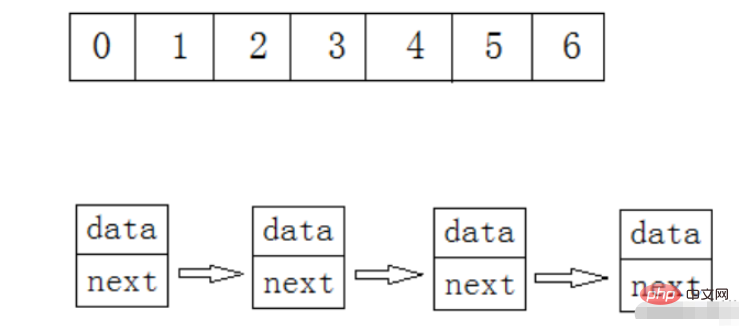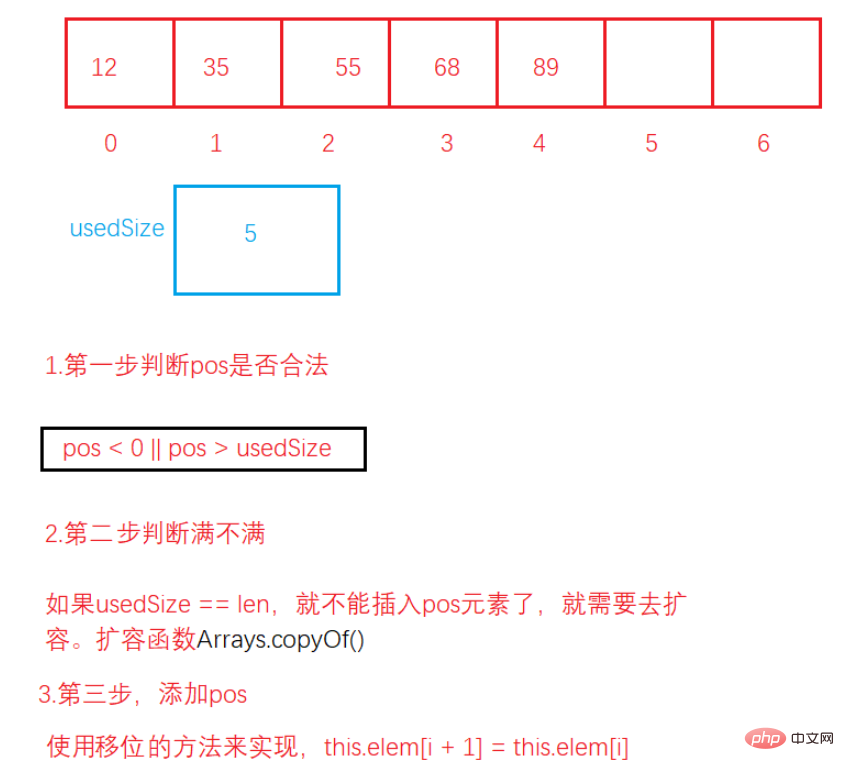如何使用Java實作順序表資料結構?
- WBOYWBOYWBOYWBOYWBOYWBOYWBOYWBOYWBOYWBOYWBOYWBOYWB轉載
- 2023-04-21 14:31:081855瀏覽
前言
線性表(linear list)是n個具有相同特性的資料元素的有限序列。線性表是一種在實際中廣泛使用的資料結構,常見 的線性表:順序表、鍊錶、棧、佇列、字串… 線性表在邏輯上是線性結構,也就說是連續的一條直線。但是在物理結構上並不一定是連續的,線性表在物理上儲存 時,通常以數組和鍊式結構的形式儲存。

一、順序表
1.1 什麼是順序表
順序表是用一段物理位址連續的儲存單元依序儲存數據元素的線性結構,一般情況下採用數組儲存。在陣列上完成資料的增刪查改 。
其實就是一個陣列。那為什麼還要寫一個順序表,直接用數組不就好了?不一樣的,寫到類別裡面就可以面向對象。
順序表一般可以分為:
靜態順序表:使用定長數組儲存
動態順序表:使用動態開闢的數組儲存
靜態順序表適用於確定知道需要存多少資料的場景.
靜態順序表的定長數組導致N定大了,空間開多了浪費,開少了不夠用.
相比之下動態順序表更靈活, 根據需要動態的分配空間大小.
二、簡單實現順序表
2.1 建立順序表
public class MyArrayList {
public int[] elem;//数组
public int usedSize;//数据的有效个数
public MyArrayList(){
this.elem = new int[10];
}
}
2.2 列印順序表
//打印顺序表
public void display(){
for (int i = 0; i < this.usedSize; i++) {
System.out.print(this.elem[i] + " ");
}
System.out.println();
}2.3 取得順序表長度
//获取顺序表长度
public int size(){
return this.usedSize;
}2.4 在pos 位置新增元素
在順序表裡面插入元素的時候所插入的位置的前面一定是存放了元素的

//在 pos 位置新填元素
public void add(int pos,int data){
if(pos < 0 || pos >usedSize){
System.out.println("pos 位置不合法!");
return;
}
if(isfull()) {
Arrays.copyOf(this.elem,2*this.elem.length);
}
for (int i = this.usedSize - 1; i >= pos; i--) {
this.elem[i + 1] = this.elem[i];
}
this.elem[pos] = data;
this.usedSize++;
}
//判断是否满
public boolean isfull(){
return this.usedSize == this.elem.length;
}2.5 判定是否包含某個元素
//判断是否包含某个元素
public boolean contains(int toFind){
for (int i = 0; i < this.usedSize; i++) {
if(this.elem[i] == toFind){
return true;
}
}
return false;
}2.6 找出某個元素對應的位置
//查找某个元素的对应位置,找不到返回-1
public int search(int toFind){
for (int i = 0; i < this.usedSize; i++) {
if(this.elem[i] == toFind){
return i;
}
}
return -1;
}2.7 取得pos 位置的元素
//获取pos位置的值
public int getPos(int pos){
if(pos < 0 || pos >= this.usedSize){
System.out.println("pos 位置不合法");
return -1;//这里说明一下,业务上的处理,不考虑
}
if(isEmpty()){
System.out.println("顺序表为空!");
return -1;
}
return this.elem[pos];
}
public boolean isEmpty(){
return this.usedSize == 0;
}2.8 給pos 位置的元素設為value
//给pos位置元素更新value
public void setPos(int pos,int value){
if (pos < 0 || pos >= this.usedSize){
System.out.println("pos 位置不合法");
return;
}
if(isEmpty()){
System.out.println("顺序表为空!");
return;
}
this.elem[pos] = value;
}2.9 刪除你想要刪除的元素
//删除第一次出现的关键字key
public void remove(int toRmove){
if (isEmpty()){
System.out.println("顺序表为空!");
return;
}
int index = search(toRmove);
if(index == -1){
System.out.println("没有你要删除的数字!");
return;
}
for (int i = index; i < this.usedSize - 1; i++) {
this.elem[i] = this.elem[i+1];
}
this.usedSize--;
//this.elem[useSize] = null;如果数组当中是引用数据类型
}2.10 清空順序表
//清空顺序表
public void clear(){
this.usedSize = 0;
}三、MyArrayList.java
import java.util.Arrays;
public class MyArrayList {
public int[] elem;
public int usedSize;
public MyArrayList(){
this.elem = new int[10];
}
//打印顺序表
public void display(){
for (int i = 0; i < this.usedSize; i++) {
System.out.print(this.elem[i] + " ");
}
System.out.println();
}
//获取顺序表长度
public int size(){
return this.usedSize;
}
//在 pos 位置新填元素
public void add(int pos,int data){
if(pos < 0 || pos >usedSize){
System.out.println("pos 位置不合法!");
return;
}
if(isfull()) {
Arrays.copyOf(this.elem,2*this.elem.length);
}
for (int i = this.usedSize - 1; i >= pos; i--) {
this.elem[i + 1] = this.elem[i];
}
this.elem[pos] = data;
this.usedSize++;
}
//判断是否满
public boolean isfull(){
return this.usedSize == this.elem.length;
}
//判断是否包含某个元素
public boolean contains(int toFind){
for (int i = 0; i < this.usedSize; i++) {
if(this.elem[i] == toFind){
return true;
}
}
return false;
}
//查找某个元素的对应位置,找不到返回-1
public int search(int toFind){
for (int i = 0; i < this.usedSize; i++) {
if(this.elem[i] == toFind){
return i;
}
}
return -1;
}
//获取pos位置的值
public int getPos(int pos){
if(pos < 0 || pos >= this.usedSize){
System.out.println("pos 位置不合法");
return -1;//这里说明一下,业务上的处理,不考虑
}
if(isEmpty()){
System.out.println("顺序表为空!");
return -1;
}
return this.elem[pos];
}
public boolean isEmpty(){
return this.usedSize == 0;
}
//给pos位置元素更新value
public void setPos(int pos,int value){
if (pos < 0 || pos >= this.usedSize){
System.out.println("pos 位置不合法");
return;
}
if(isEmpty()){
System.out.println("顺序表为空!");
return;
}
this.elem[pos] = value;
}
//删除第一次出现的关键字key
public void remove(int toRmove){
if (isEmpty()){
System.out.println("顺序表为空!");
return;
}
int index = search(toRmove);
if(index == -1){
System.out.println("没有你要删除的数字!");
return;
}
for (int i = index; i < this.usedSize - 1; i++) {
this.elem[i] = this.elem[i+1];
}
this.usedSize--;
//this.elem[useSize] = null;如果数组当中是引用数据类型
}
//清空顺序表
public void clear(){
this.usedSize = 0;
}
}四、Test.java
public class Test {
public static void main(String[] args) {
MyArrayList myArrayList = new MyArrayList();
myArrayList.add(0,1);
myArrayList.add(1,2);
myArrayList.add(2,3);
myArrayList.add(3,4);
myArrayList.add(4,5);
myArrayList.display();
System.out.println(myArrayList.contains(3));
System.out.println(myArrayList.getPos(3));
myArrayList.setPos(0,99);
myArrayList.display();
}
}以上是如何使用Java實作順序表資料結構?的詳細內容。更多資訊請關注PHP中文網其他相關文章!
陳述:
本文轉載於:yisu.com。如有侵權,請聯絡admin@php.cn刪除
上一篇:Java集合和數組的差別是什麼?下一篇:Java集合和數組的差別是什麼?

